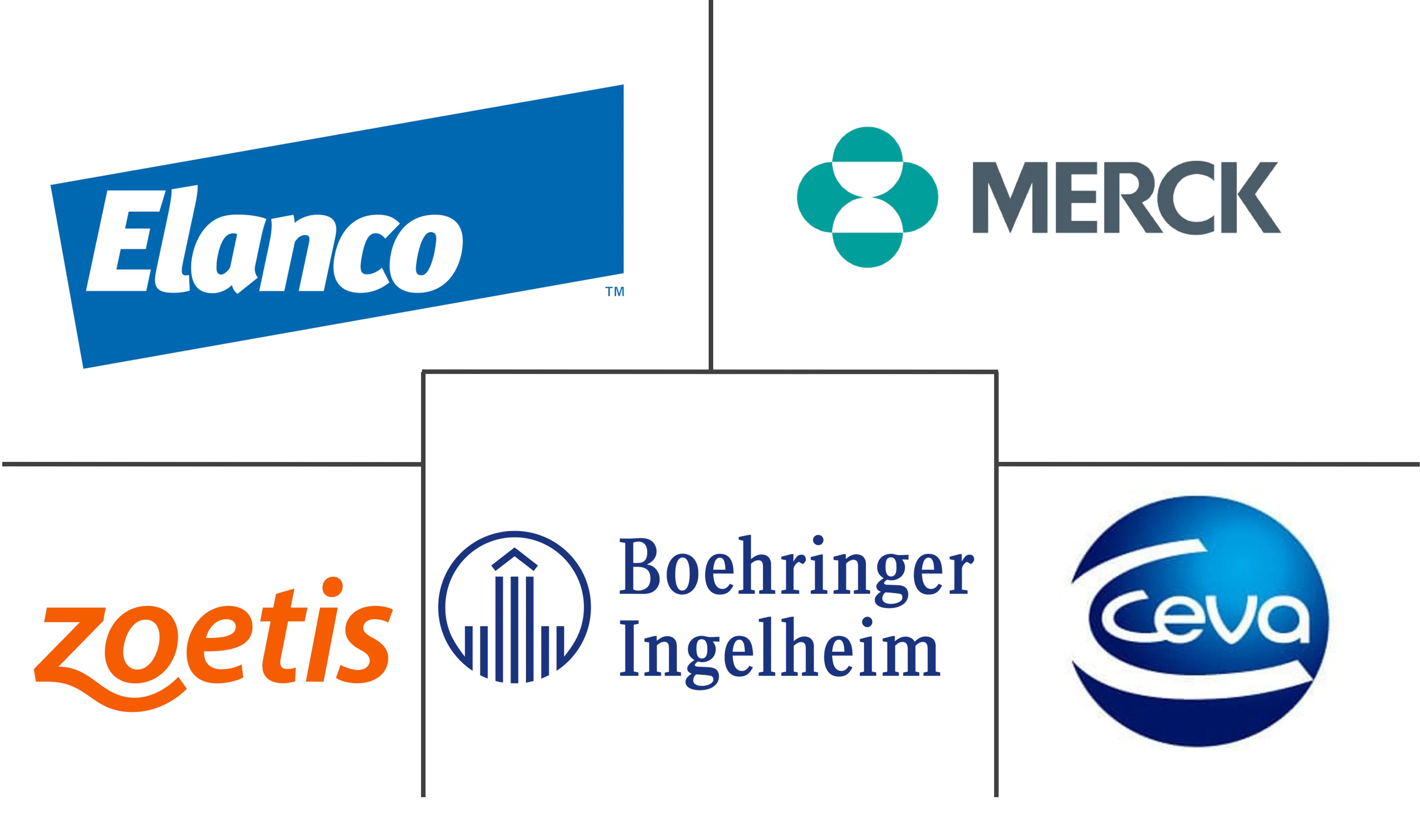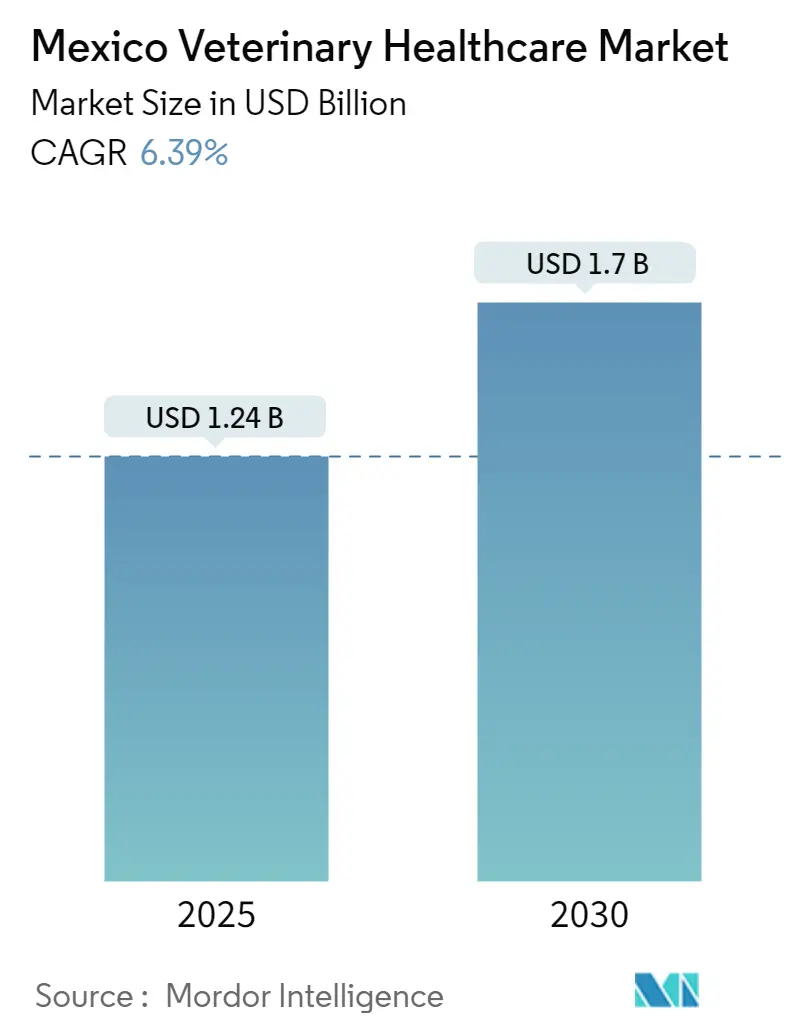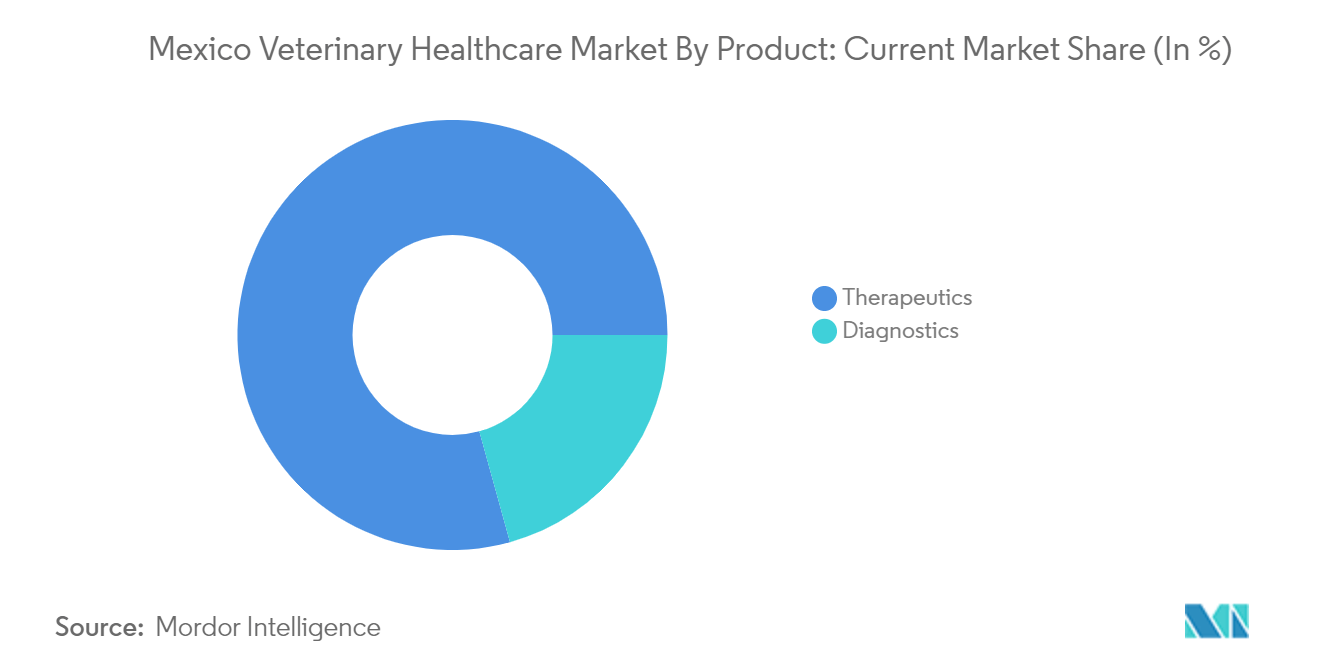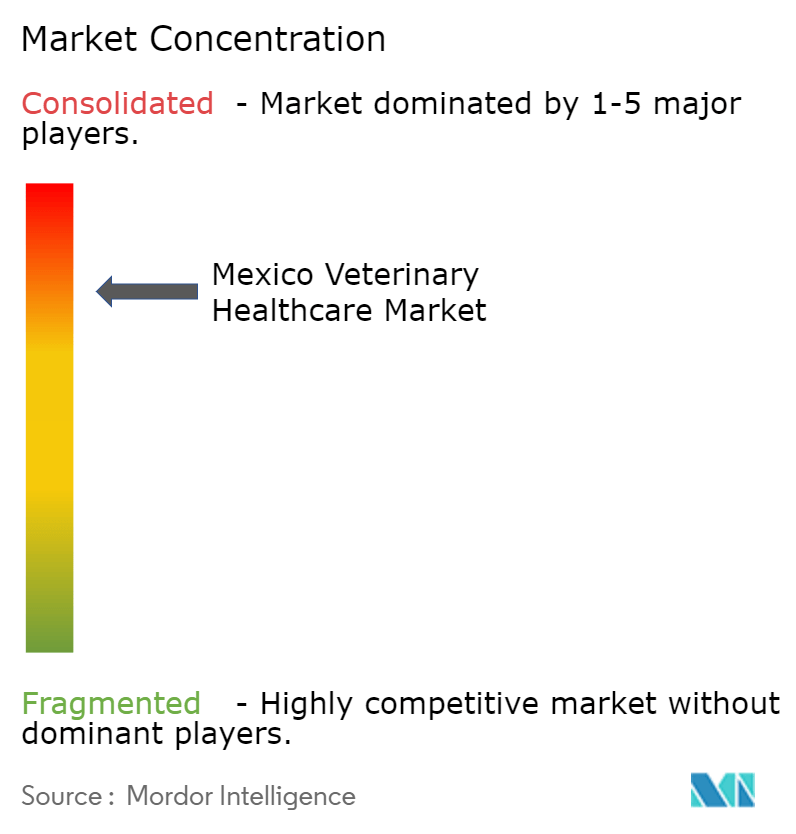Mexico Veterinary Healthcare Market Analysis
The Mexico Veterinary Healthcare Market size is estimated at USD 1.24 billion in 2025, and is expected to reach USD 1.70 billion by 2030, at a CAGR of 6.39% during the forecast period (2025-2030).
The Mexico Veterinary Healthcare market is experiencing significant growth, driven by fundamental megatrends that are reshaping the industry landscape. The increasing pet adoption rates, growing awareness of Veterinary Medicine and Animal Wellness, and the rising importance of food safety in livestock production are key factors propelling the market forward. These overarching trends are closely intertwined with the specific drivers of advanced technologies and the focus on productivity, which are playing crucial roles in transforming Veterinary Services and Animal Healthcare practices across Mexico.
Advanced Technologies Leading to Innovations in Animal Healthcare: The integration of cutting-edge technologies is revolutionizing Veterinary Healthcare in Mexico. This trend is characterized by the development of innovative Veterinary Diagnostics tools, treatment methods, and Animal Preventive Care solutions. The presence of key industry players is accelerating the availability of technologically advanced Veterinary Equipment and Animal Medical Devices in the country. Notable initiatives include the launch of new vaccination projects, such as the United States-Mexico partnership to evaluate a new Animal Vaccine for bovine tuberculosis. Furthermore, the digitization of Animal Healthcare services is gaining momentum, with companies like Folio3 Software Inc. introducing mobile-based solutions for farmers, ranchers, and Animal Medical Care specialists. These technological advancements are not only improving the quality of care but also making Veterinary Services more accessible and efficient across Mexico.
Increasing Productivity at the Risk of Emerging Zoonosis: The drive for increased productivity in animal husbandry is a double-edged sword, bringing both opportunities and challenges to Mexico's Veterinary Healthcare sector. On one hand, efforts to boost livestock productivity are leading to advancements in animal nutrition, breeding techniques, and disease management. However, this push for higher yields is also raising concerns about the potential emergence and spread of zoonotic diseases. The World Health Organization reported over 200 prevailing zoonosis diseases worldwide, highlighting the critical need for vigilant healthcare practices. In response, Mexico is taking proactive measures, such as implementing virtual training programs for Veterinarians in Mexico to address serious animal diseases. The Ministry of Agriculture and Rural Development trained more than 2,000 Veterinarians in Mexico, focusing on various diseases and their treatments. Additionally, initiatives like the WEAN UP program demonstrate a holistic approach to Animal Preventive Care management, particularly in the swine industry.
Mexico Veterinary Healthcare Market Trends
Therapeutics: Driving Force in Mexico's Veterinary Healthcare Market
Segment Overview: The therapeutics segment, including Veterinary Pharmaceuticals and Animal Therapeutics, stands as the cornerstone of Mexico's Veterinary Healthcare market. This segment encompasses a wide array of products designed to prevent, treat, and manage various animal health conditions. Therapeutics play a crucial role in maintaining Animal Health, enhancing productivity in livestock, and ensuring the well-being of companion animals. The segment's dominance is evident, accounting for approximately 79% of the current market size.
Growth Drivers: Several megatrends are propelling the therapeutics segment forward. The increasing pet adoption rates in Mexico are fueling demand for advanced Veterinary Medicine. Concurrently, the growing livestock industry is necessitating more sophisticated Animal Pharmaceuticals. The rise of zoonotic diseases has heightened awareness about the importance of Animal Vaccine, particularly benefiting the vaccines sub-segment. Looking ahead, the therapeutics segment is poised to maintain its market dominance, driven by ongoing innovations in drug delivery systems and the development of more targeted and effective treatments.
Competitive Landscape: In this highly competitive segment, market players are focusing on research and development to gain an edge. Strategies revolve around developing novel formulations, expanding product portfolios, and enhancing distribution networks. Companies are also investing in digital technologies to improve drug efficacy monitoring and personalized treatment plans, including advanced Veterinary Equipment and Veterinary Supplies. As the market evolves, players must remain vigilant about potential disruptions, such as the emergence of alternative therapies or changes in regulatory landscapes that could impact drug approvals and usage guidelines.
Ruminants: Emerging Growth Catalysts in Mexico's Veterinary Healthcare Market
Segment Dynamics: The ruminant segment emerges as the fastest-growing component within the animal type categorization of Mexico's Veterinary Healthcare market. This segment encompasses cattle, sheep, goats, and other ruminant species, playing a crucial role in the country's livestock industry. The segment's rapid ascent is evidenced by its projected growth rate, with a forecasted CAGR of 7.25% between 2024 and 2029, outpacing other animal type segments in the market.
Market Drivers: Several factors are propelling the growth of the ruminant segment. The increasing demand for dairy and meat products in Mexico is driving the expansion and intensification of ruminant farming. Concurrently, there's a growing emphasis on improving livestock productivity and health, leading to increased investment in Veterinary Diagnostics for ruminants. The rise of zoonotic diseases and the need for better disease management in livestock are also contributing to the segment's expansion. As we look to the future, the ruminant segment is expected to play an increasingly significant role in shaping the overall Veterinary Healthcare landscape in Mexico, driven by the country's focus on enhancing its livestock sector.
Strategic Imperatives: To capitalize on the segment's growth potential, companies are adopting various strategies tailored to the ruminant sector. Key focus areas include developing specialized vaccines and treatments for ruminant-specific diseases, as well as creating nutritional supplements to enhance productivity. This includes the development of Animal Drugs and Animal Preventive Care products. Partnerships with large-scale dairy and beef producers, along with educational initiatives for small-scale farmers, are becoming common. Market players should also be prepared for potential disruptions, such as the integration of precision livestock farming technologies or changes in regulations regarding antibiotic use in food-producing animals, which could significantly alter the competitive landscape in the ruminant healthcare sector.
Mexico Veterinary Healthcare Industry Overview
Market Dominance: Global Players Lead Consolidated Landscape
The Mexico Veterinary Healthcare Market is characterized by the dominance of global players, with multinational conglomerates holding significant market share. The market structure is fairly consolidated, with a few key players controlling a substantial portion of the industry. This consolidation is evident from the presence of major global companies such as Zoetis, Merck & Co. Inc., Elanco Animal Health Incorporated, and Boehringer Ingelheim International GMBH. These companies leverage their extensive research and development capabilities, broad product portfolios, and global distribution networks to maintain their market positions, particularly in areas such as Companion Animal Healthcare and Animal Wellness.
Market Leaders: Innovation and Diversification Drive Success
The top players in the Mexico Veterinary Healthcare Market, including Zoetis, Merck, Elanco, and Boehringer Ingelheim, share common characteristics that contribute to their market leadership. These companies demonstrate a strong focus on innovation, evidenced by their investments in advanced technologies and new product development. For instance, Zoetis acquired Virtual Recall to enhance its service offerings, while Merck has been involved in launching innovative projects such as a new vaccine for bovine tuberculosis. These market leaders also maintain diversified product portfolios spanning various segments, including vaccines, parasiticides, and anti-infectives. These players dominate the vaccines segment, which is the largest segment in this market, underscoring the importance of this product category in maintaining market leadership.
Strategies for Future Success: Technology and Market Expansion
For market players to increase their market share and maintain competitiveness, several key strategies emerge as critical. Investment in advanced technologies, such as remote monitoring systems, automated dairy installations, and herd management systems, will be crucial for driving innovation and improving product efficacy. Expanding product portfolios to address the growing demand across various animal types, particularly in the fast-growing ruminants segment, will be essential. Companies should also focus on strategic mergers, acquisitions, and collaborations to strengthen their market presence and access new technologies. Additionally, capitalizing on the trend of pet owners from the United States and Canada seeking affordable Veterinary Services in Mexico presents an opportunity for market expansion. Developing cost-effective solutions and enhancing service offerings in this segment could provide a competitive edge in the evolving market landscape.
Mexico Veterinary Healthcare Market Leaders
-
Zoetis Inc.
-
Merck Co. Inc.
-
Boehringer Ingelheim
-
Ceva Santé Animale
-
Elanco
- *Disclaimer: Major Players sorted in no particular order
Mexico Veterinary Healthcare Market News
- September 2024: Mexico City's Ministry of Health, via its Public Health Services, unveiled a reinforcement campaign for rabies vaccinations in canines and felines. The initiative aims to administer 405,902 doses to dogs and cats across the capital's 16 municipalities.
- September 2024: Martí Batres, one of the leading the Mexico City Government, inaugurated the "Michigan, City of Cats" animal shelter. This new facility will be situated within the Animal Surveillance Brigade, part of the capital's Citizen Security Secretariat.
Mexico Veterinary Healthcare Industry Segmentation
As per the scope of the report, the Mexican veterinary healthcare market comprises therapeutic and diagnostics products and solutions for companion and farm animals. Companion animals can be tamed or adopted for companionship or as house/office guards, while farm animals are raised for meat and milk-related products. Companion animals include canine, feline, and equine. Farm animals include bovine, poultry, and porcine.
The Mexican veterinary healthcare market is segmented by product and animal type. By product, the market is segmented into therapeutics and diagnostics. By therapeutics, the market is segmented into vaccines, parasiticides, anti-infectives, medical feed additives, and other therapeutics. By diagnostics, the market is segmented into immunodiagnostic tests, molecular diagnostics, diagnostic imaging, clinical chemistry, and other diagnostics. By animal type, the market is segmented into dogs, cats, horses, ruminants, swine, poultry, and other animals. The report offers the value in USD for these segments.
| By Product | Therapeutics | Vaccines | |
| Parasiticides | |||
| Anti-infectives | |||
| Medical Feed Additives | |||
| Other Therapeutics | |||
| Diagnostics | Immunodiagnostic Tests | ||
| Molecular Diagnostics | |||
| Diagnostic Imaging | |||
| Clinical Chemistry | |||
| Other Diagnostics | |||
| By Animal Type | Dogs and Cats | ||
| Horses | |||
| Ruminants | |||
| Swine | |||
| Poultry | |||
| Other Animals | |||
Mexico Veterinary Healthcare Market Research FAQs
How big is the Mexico Veterinary Healthcare Market?
The Mexico Veterinary Healthcare Market size is expected to reach USD 1.24 billion in 2025 and grow at a CAGR of 6.39% to reach USD 1.70 billion by 2030.
What is the current Mexico Veterinary Healthcare Market size?
In 2025, the Mexico Veterinary Healthcare Market size is expected to reach USD 1.24 billion.
Who are the key players in Mexico Veterinary Healthcare Market?
Zoetis Inc., Merck Co. Inc., Boehringer Ingelheim, Ceva Santé Animale and Elanco are the major companies operating in the Mexico Veterinary Healthcare Market.
What years does this Mexico Veterinary Healthcare Market cover, and what was the market size in 2024?
In 2024, the Mexico Veterinary Healthcare Market size was estimated at USD 1.16 billion. The report covers the Mexico Veterinary Healthcare Market historical market size for years: 2019, 2020, 2021, 2022, 2023 and 2024. The report also forecasts the Mexico Veterinary Healthcare Market size for years: 2025, 2026, 2027, 2028, 2029 and 2030.
Our Best Selling Reports
Mexico Veterinary Healthcare Industry Report
Statistics for the 2025 Mexico Veterinary Healthcare market share, size and revenue growth rate, created by Mordor Intelligence™ Industry Reports. Mexico Veterinary Healthcare analysis includes a market forecast outlook for 2025 to 2030 and historical overview. Get a sample of this industry analysis as a free report PDF download.







